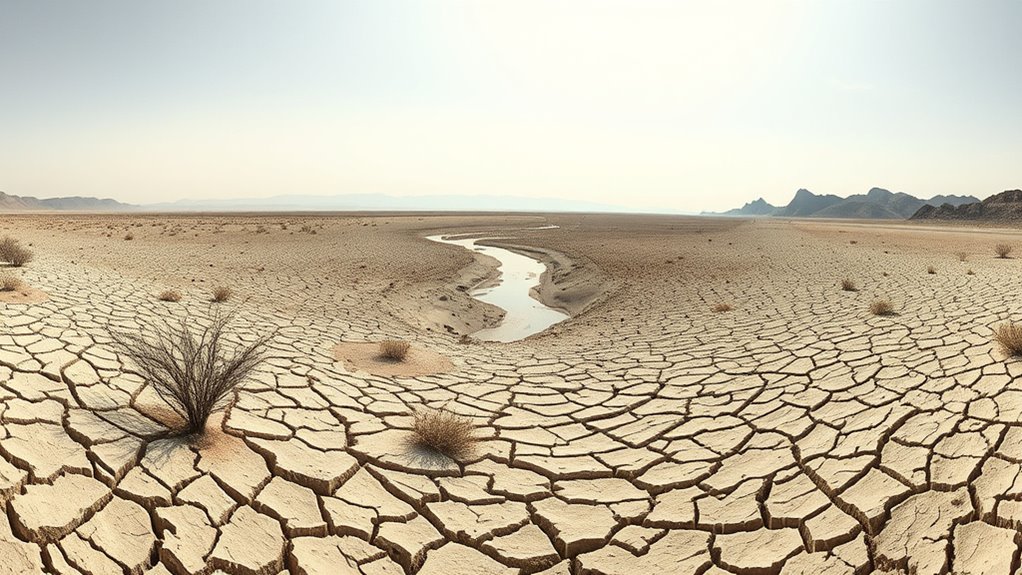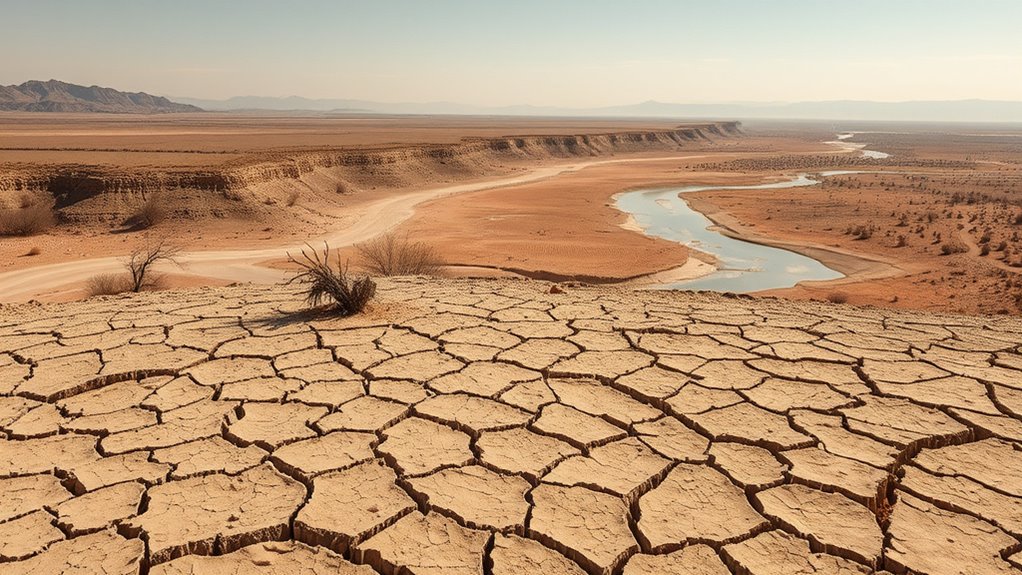In 2025, the drought in the West has worsened, draining reservoirs and lowering snowpack, which means water scarcity affects your daily life, agriculture, and wildlife. Cities are enforcing strict water restrictions, while farmers face tough decisions like cutting crops or switching to drought-tolerant varieties. Environmental impacts threaten ecosystems, and groundwater depletion adds to the crisis. To learn how communities are coping and what solutions are emerging, keep exploring this urgent water update.
Key Takeaways
- Reservoir levels are critically low, and snowpack remains below average, constraining natural water replenishment in 2025.
- Agriculture faces severe water shortages, leading to crop reductions, livestock losses, and rising food prices.
- Urban areas are enforcing water restrictions and exploring desalination and recycled water solutions.
- Ecosystems suffer from reduced river flows, groundwater overdraft, and ecological imbalance due to prolonged drought.
- Immediate conservation efforts and innovative water management are essential to prevent worsening shortages in 2025.

Is the world prepared for the water crisis looming in 2025? If you’re paying attention to the current drought conditions in the West, you already know that water scarcity is a growing concern. As reservoirs dwindle and snowpack levels remain below average, the strain on water supplies intensifies. This situation impacts not just daily life but also critical sectors like agriculture and urban areas. You’ll notice that agricultural impacts are becoming more severe, with farmers struggling to keep crops alive and livestock watered. Reduced water availability means they have to make tough choices—either cut back on planting, switch to less water-intensive crops, or face economic losses. These decisions ripple through the food supply chain, potentially leading to higher prices and shortages. Meanwhile, urban communities are increasingly adopting water restrictions to stretch limited supplies. You might see restrictions on lawn watering, car washing, or filling pools, all aimed at conserving what little water remains. These restrictions aren’t just inconveniences; they’re necessary measures to prevent complete water outages. Yet, they also highlight the vulnerability of city infrastructure that wasn’t designed for such prolonged shortages. As the drought persists, the pressure on municipal water systems grows, forcing officials to implement stricter restrictions and seek alternative sources. You might notice that some cities are even contemplating more drastic measures, like mandatory water rationing or investing heavily in desalination plants and recycled water programs. The impacts extend beyond immediate supply issues—there’s an environmental toll too. Reduced river flows harm aquatic ecosystems, while groundwater overdraft leads to land subsidence and long-term depletion of aquifers. These ecological consequences threaten the sustainability of water sources for future generations. Additionally, understanding the water cycle is crucial for developing sustainable solutions to these challenges. As a person living through this crisis, you’re likely feeling the effects firsthand—whether through higher water bills, restrictions on outdoor usage, or concerns about food security. The situation demands urgent action, but it also calls for a shift in how we manage water resources. You can help by conserving water in your daily routines, advocating for smarter water policies, and supporting sustainable practices. The drought’s impact on agriculture and urban water use underscores the urgent need for resilience and innovation. Without decisive intervention, the water crisis could become even more severe by 2025, affecting everyone, everywhere. It’s essential to recognize that water scarcity isn’t just an environmental issue; it’s a social, economic, and political challenge that requires coordinated effort from individuals, communities, and governments alike.
Frequently Asked Questions
How Will Drought Impact Agricultural Jobs in the West by 2025?
You’ll likely see agricultural jobs become more uncertain by 2025 as drought worsens. Water shortages may reduce crop yields, leading to layoffs and unstable employment. Agricultural laborers might face job insecurity, with farms cutting back on staff or shifting to less water-dependent crops. Staying adaptable and acquiring new skills can help you navigate these challenges, but the drought’s impact on job security will be significant in the coming years.
What Are the Long-Term Ecological Effects of Water Shortages?
Imagine once-lush landscapes turning barren, as you witness ecosystem degradation caused by prolonged water shortages. Long-term, groundwater depletion worsens these effects, leading to shrinking rivers, dying plants, and lost habitats. You’ll see fewer wildlife and disrupted food chains. This ecological decline threatens biodiversity and the health of the environment, making it harder for ecosystems to recover, and leaving lasting scars on the land you cherish.
Are There Any Upcoming Policies to Address Water Equity Issues?
Yes, upcoming water policies focus on addressing equity issues through new equity initiatives. You can expect these policies to prioritize fair water distribution, especially for underserved communities. Local governments are working on water policy reforms that guarantee equitable access, improve infrastructure, and involve community participation. Staying informed and engaging with local planning efforts helps you support and benefit from these initiatives, ensuring fair water access for everyone in your area.
How Will Drought Affect Urban Water Prices in 2025?
You’ll likely see urban water prices rise in 2025 due to increased drought conditions. As urban demand grows and water scarcity intensifies, prices become more sensitive to shortages, reflecting higher costs of supply. Price elasticity means that even small drought impacts can markedly boost rates, encouraging conservation. Expect utilities to implement tiered pricing or incentives to manage demand and mitigate the economic impact on households and businesses.
What Innovative Water Conservation Technologies Are Being Developed?
Did you know that smart irrigation systems can reduce water use by up to 30%? You’ll find new innovations like water recycling technologies that treat and reuse greywater, cutting consumption considerably. These advancements help conserve water efficiently. As you adopt smart irrigation, you’ll optimize watering schedules, and water recycling enables you to reuse wastewater safely, making your efforts vital in tackling the ongoing drought challenges in 2025.
Conclusion
By 2025, if you don’t act now, you might find yourself living in a desert of your own making, where water is so scarce it’s practically a myth. The drought’s grip could turn your daily life into a never-ending struggle for a single drop. This isn’t just a crisis — it’s a warning that if you don’t step up, you’ll be washing your dishes with tears and watering your plants with hope. The choice is yours.










